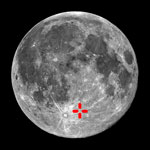|
 Stöfler
est un cratère de 126 Km et profond de 2800 m situé sur le
plateau continental dans la partie méridionale de la Lune. Il se trouve à
l'ouest du cratère Maurolycus. Le cratère tordu Fernelius (65 Km) est
attaché au mur nordique. Le cratère Faraday (70 Km, 4090 m) a recouvert et
endommagé la muraille orientale de Stöfler. Faraday étant aussi couvert
alternativement par plusieurs plus petits cratères. La muraille de Stöfler
est érodée, mais l'ensemble reste relativement intact excepté le mur
recouvert par Faraday. Stöfler K (19 Km) à impacté la muraille Nord-ouest
et Stöfler F (18 Km) la base du mur intérieur Sud-ouest. Le plancher du
cratère a été inondé par la lave, et est relativement plat et sans
particularité dans la moitié Ouest, chaotique à l’Est. Le plancher a un bas
albédo*, rendant le cratère relativement facile à identifier car il est l'un
des quelques cratères dans cette région de la surface lunaire qui ont un
plancher foncé. Au travers du plancher, on peut voir des traces blanches de
l’éjecta du cratère Tycho et de nombreux craterlets.
Stöfler
est un cratère de 126 Km et profond de 2800 m situé sur le
plateau continental dans la partie méridionale de la Lune. Il se trouve à
l'ouest du cratère Maurolycus. Le cratère tordu Fernelius (65 Km) est
attaché au mur nordique. Le cratère Faraday (70 Km, 4090 m) a recouvert et
endommagé la muraille orientale de Stöfler. Faraday étant aussi couvert
alternativement par plusieurs plus petits cratères. La muraille de Stöfler
est érodée, mais l'ensemble reste relativement intact excepté le mur
recouvert par Faraday. Stöfler K (19 Km) à impacté la muraille Nord-ouest
et Stöfler F (18 Km) la base du mur intérieur Sud-ouest. Le plancher du
cratère a été inondé par la lave, et est relativement plat et sans
particularité dans la moitié Ouest, chaotique à l’Est. Le plancher a un bas
albédo*, rendant le cratère relativement facile à identifier car il est l'un
des quelques cratères dans cette région de la surface lunaire qui ont un
plancher foncé. Au travers du plancher, on peut voir des traces blanches de
l’éjecta du cratère Tycho et de nombreux craterlets.
 (English version,
Wikipedia copyright)
(English version,
Wikipedia copyright)
Stöfler
is a large lunar impact crater located in the crater-riddled southern
highlands. It sits to the west of Maurolycus crater. The distorted Fernelius
crater is attached to the northern rim, and Miller and Nasireddin craters
lie to the west. The Faraday crater has overlain and damaged the western rim,
and this crater in turn has been overlaid by several smaller craters.
The rim of Stöfler is worn and eroded, but the outline remains relatively
intact except where overlain by Faraday. The smaller 'Stöfler K' intrudes
into the northwest rim, and 'Stöfler F' forms an indentation into the base
of the southwest interior wall.
The crater floor has been filled in with deposits, either from lava flows or
ejecta from basin impacts, and is relatively flat and featureless in the
northwest half. If there was a central peak, it has now become buried. The
floor has a low albedo, making the crater relatively easy to identify as it
is one of the few craters in this region of the lunar surface that have a
dark floor. Traces of bright ray material from Tycho crater, located to the
west, can been seen across the floor.
|



